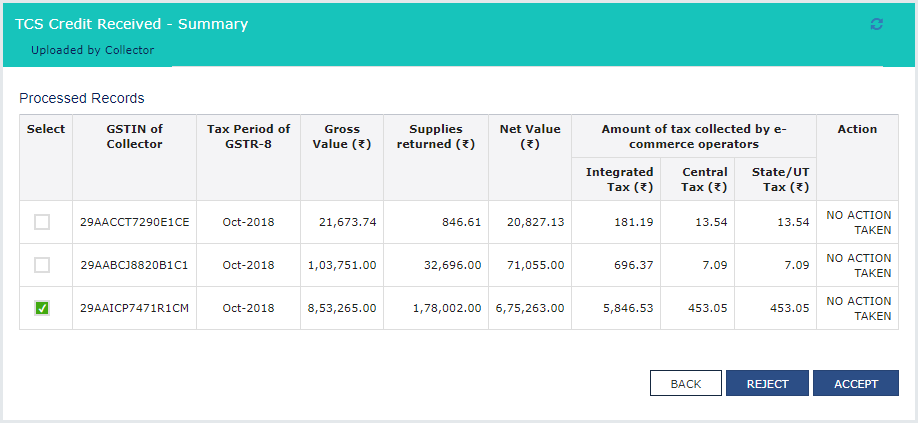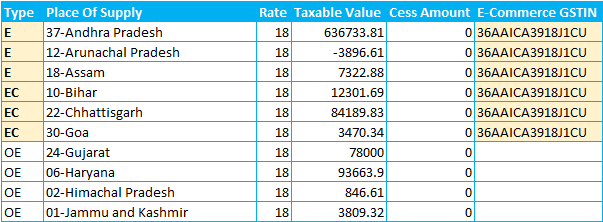 As we all know, TCS (Tax Collected at Source) under Section-52 of CGST Act, 2017 came into force starting from 01 Oct 2018. I know, it is confusing for many of us & even for our Tax Consultants. When we speak about TCS (Tax Collected at Source), TDS (Tax Deducted at Source) etc, people often tag it to Income Tax, which is not always true. Terms like TCS & TDS are used in the context of both Income Tax & Goods and Services Tax (GST). Let’s keep TDS aside for a while; I will cover it in a different article later on. Let’s get into the details of TCS & the implication on e-Commerce.
TCS & it’s relevance to E-Commerce
One of the intent behind Tax Collected At Source (TCS) under Section-52 of CGST Act, 2017 is to track all the sales happening through e-Commerce Platforms like Amazon, Flipkart, PayTm, Snapdeal etc. Till date, there was no mechanism or a mandate for marketplaces to report the Sales happening through their eCommerce Platforms to the concerned Tax Authorities.
As we all know, TCS (Tax Collected at Source) under Section-52 of CGST Act, 2017 came into force starting from 01 Oct 2018. I know, it is confusing for many of us & even for our Tax Consultants. When we speak about TCS (Tax Collected at Source), TDS (Tax Deducted at Source) etc, people often tag it to Income Tax, which is not always true. Terms like TCS & TDS are used in the context of both Income Tax & Goods and Services Tax (GST). Let’s keep TDS aside for a while; I will cover it in a different article later on. Let’s get into the details of TCS & the implication on e-Commerce.
TCS & it’s relevance to E-Commerce
One of the intent behind Tax Collected At Source (TCS) under Section-52 of CGST Act, 2017 is to track all the sales happening through e-Commerce Platforms like Amazon, Flipkart, PayTm, Snapdeal etc. Till date, there was no mechanism or a mandate for marketplaces to report the Sales happening through their eCommerce Platforms to the concerned Tax Authorities.
With the introduction of TCS under GST Regime, every sale happening through E-Commerce Portals will be tracked at an individual transaction level and reported to Govt. And, e-Commerce marketplaces will be reporting the NET Taxable Value of the Sale along with the TCS Collected in GSTR-8 Return every month for every registered seller on their platform having a valid GSTIN number.As per the CGST Act, marketplaces should collect 1% TCS of the NET Taxable Value of the sale for every Seller on their platforms, and pay the same to the Govt. on behalf of the e-Commerce Merchants through GSTR-8 Return on or before 10th every month. This makes the transactions made through e-Commerce Marketplaces transparent & the accurate turnover information is reported to Govt for every seller on their platform on a monthly basis. Hence, it is important for every e-Commerce Merchants to make sure that they report accurate sales figures when they file GSTR-1 returns every month.
Starting from the month of Oct 2018, GSTR-1 Due Date has been revised to 11th of next month in case of the people who opted for Monthly Returns. Due Date unchanged for those who opted for Quarterly Return Filing.Who should collect TCS & File Returns under GST (GSTR-8) in the context of e-Commerce? As per the CGST Act, e-Commerce Operators (a.k.a. Marketplaces) should obtain a GSTIN called E-Commerce Operator GSTIN in every state in which they have registered merchants. This is different from a normal GSTIN though it looks like a Regular GSTIN number; it will be having letter C as the 14th letter while regular GSTIN would be having Z as the 14th letter.
Marketplaces will collect 1% on IGST or 0.5% on CGST plus 0.5% SGST as TCS depending on whether the transaction is Inter-state or Intra-state.And, they should file GSTR-8 in all states from which they have registered sellers & deposit the TCS collected under each merchant’s GSTIN Number. Once they file GSTR-8, it will be displayed in GSTR-2A of Sellers GSTIN login under Part-C > TCS Credits section for each month. Marketplaces would be reporting Gross Sales & Returns, NET Taxable Value liable to collect TCS along with the TCS collected against IGST, CGST & SGST every month. When Marketplaces deduct TCS? e-Commerce Operators/Marketplaces should deduct 1% TCS of the NET Taxable Value of sales when a transaction occurs. The transaction can be sales or a return. For example, marketplaces will collect 1% TCS when a product which is invoiced in Oct & they file GSTR-8 for that order in the month of Oct itself. If the order returns back, it will be accounted in the respective month of return & necessary adjustments will be made to reverse the TCS collected for the order. Which means, the reversal of TCS in case of a return can happen in Oct itself (if product returned in oct) or it can happen in any of the future months depending on the Return Period of each category. We must see the TCS collection details in our Payment Settlement report & in the monthly consolidated sales report shared by the marketplaces. Marketplaces should pay the same amount collected under TCS on behalf of the seller to the Govt when they file the GSTR-8 return for each month. How to validate the NET Sales figures from Sales Reports with the value reported by Marketplaces in TCS Return? The NET Taxable value would be calculated as the Total of Taxable value for the sale happened during the current month minus (-) the Total of Taxable value for the returns received during the month. Returns received in a particulate month can be for the sale happened during the same month itself or for a sale happened during one of the previous months.
Which means, the NET Taxable Sales value reported by Marketplaces under GSTR-8 would always be greater than the NET Sales figures posted by us when we file GSTR-1, at least for the month of Oct 2018 and for a couple of months thereafter.This is because we adjust the NET value of the Returns we received for a Sale prior to TCS against the Sales Value in the current month after TCS. When we consolidate the NET Sales for a specific month, we would always consider NET sales happened during the current month & the NET returns received in the current month. Which means, we can very well receive a return for a sale happened prior to 01 Oct 2018 as well. Let’s define the details as below. (1) NET Taxable Value of Sales for the Current Month (2) NET Taxable Value of Returns received for orders after 01 Oct 2018 (3) NET Taxable Value of Returns received for orders before 01 Oct 2018 NET of Turnover as per GSTR-1 = (1) – (2) – (3) NET of Turnover posted by Marketplaces = (1) – (2) This means that we will always see an inflated Taxable value for Sales posted in TCS Returns by marketplaces, at least for the initial few months until (3) becomes Zero.
Hence, to validate the TCS Turnover with the value from Marketplace reports, we should always filter out all Orders invoiced before 01 Oct 2018.When, Where & How we can find out the Data filed by Marketplaces in GSTR-8 Return? Marketplaces should file GSTR-8 on or before the 10th of the next month. Once the return is filed by the Marketplaces, it will start appearing in GSTR-2A > Part-C > TCS Credits Section like the one shown below.
 How to Claim the TCS Credits?
Once Marketplaces file GSTR-8 Return, it will come under “TDS & TCS Credits Received” section of Return Dashboard. To view and act on it, you should navigate to Return Dashboard > Search for the Current Month > TDS & TCS Credits Received > Prepare Online > TDS Credits Received section to view it & act on it. The section will look like below.
How to Claim the TCS Credits?
Once Marketplaces file GSTR-8 Return, it will come under “TDS & TCS Credits Received” section of Return Dashboard. To view and act on it, you should navigate to Return Dashboard > Search for the Current Month > TDS & TCS Credits Received > Prepare Online > TDS Credits Received section to view it & act on it. The section will look like below.
 You can either Accept or Reject the filing by the marketplaces and file the acceptance return. Once you file the acceptance, the Electronic Cash Ledger balance would get updated with the TCS Credits received.
A detailed Step-by-Step process to Claim & avail the TCS Credits while filing GSTR-3B explained in the article, How to claim & utilize TCS Credits filed by eCommerce Marketplaces under GST Regime I would recommend you to read it before proceeding with GSTR-3B return filing.
Changes in GSTR-1 Filing Process after TCS
Until the GSTR returns for the month of Sept 2018, we were reporting e-Commerce sales under “Other than E-Commerce (OE)”. As per theory, we should start reporting the e-Commerce Sales from Oct 2018 onwards as the sales under “E-Commerce (E)” itself instead of reporting it under Other than E-Commerce (OE), by quoting E-Commerce Operator GSTIN of each marketplace. Which means, we should start reporting Sales in GSTR-1 with State-wise, GST Rate-wise & Marketplace-wise numbers.
You can either Accept or Reject the filing by the marketplaces and file the acceptance return. Once you file the acceptance, the Electronic Cash Ledger balance would get updated with the TCS Credits received.
A detailed Step-by-Step process to Claim & avail the TCS Credits while filing GSTR-3B explained in the article, How to claim & utilize TCS Credits filed by eCommerce Marketplaces under GST Regime I would recommend you to read it before proceeding with GSTR-3B return filing.
Changes in GSTR-1 Filing Process after TCS
Until the GSTR returns for the month of Sept 2018, we were reporting e-Commerce sales under “Other than E-Commerce (OE)”. As per theory, we should start reporting the e-Commerce Sales from Oct 2018 onwards as the sales under “E-Commerce (E)” itself instead of reporting it under Other than E-Commerce (OE), by quoting E-Commerce Operator GSTIN of each marketplace. Which means, we should start reporting Sales in GSTR-1 with State-wise, GST Rate-wise & Marketplace-wise numbers.
Unfortunately, GST Return Filing workflow is not yet equipped with an option to report the sales under “E-Commerce (E)” using E-Commerce operator GSTIN of each marketplace.
 As per theory, we should report sales marketplace-wise as well to match it with the TCS Reporting by marketplaces under GSTR-8. Which means, we may have to wait to see another tab to appear for “E-Commerce” to enter sales figures via Prepare Online mode for GSTR-1.
The situation is same in case of the latest version of GST Offline Utility (version 2.2.9) for GSTR-1 as well. There is a note in the Utility that reads “Note: Please do not mention the E-Commerce Tin while declaring your outward supplies in the worksheets b2b, b2cl, b2cs, b2ba, b2cla, b2csa as the related provisions are not yet notified.”
As per theory, we should report sales marketplace-wise as well to match it with the TCS Reporting by marketplaces under GSTR-8. Which means, we may have to wait to see another tab to appear for “E-Commerce” to enter sales figures via Prepare Online mode for GSTR-1.
The situation is same in case of the latest version of GST Offline Utility (version 2.2.9) for GSTR-1 as well. There is a note in the Utility that reads “Note: Please do not mention the E-Commerce Tin while declaring your outward supplies in the worksheets b2b, b2cl, b2cs, b2ba, b2cla, b2csa as the related provisions are not yet notified.”
 GST Offline Utility throws an error if you try to upload a file with “E” or with “EC” under “Type” column along with E-Commerce GSTIN. An example is shown below.
GST Offline Utility throws an error if you try to upload a file with “E” or with “EC” under “Type” column along with E-Commerce GSTIN. An example is shown below.

To conclude, it might be “safe” to continue reporting the Sales Figures in GSTR-1 as usual for Oct 2018 at least, if you’re seeing TCS filing data from marketplaces & if you’re able to match the figures.But in the near future, we will need to start reporting the E-Commerce sales by quoting E-Commerce Operator GSTIN, when GST system is ready. Can we claim TCS Collected as Refund if we could not offset it against Output GST? It is very well possible to have a scenario where you won’t be able to offset TCS against your Output GST. In most cases where there is an Inverted Tax Structure or if there is an Export income, you might be having excess ITC (Input Tax Credit) accumulated in your Electronic Credit Ledger. In that case, you will never be able to utilize the TCS Collected by Marketplaces for paying Output GST.
As per the Process workflow, TCS will finally flow into Electronic Cash Ledger unlike Input Tax Credit (ITC). As of now, we can get a refund of cash accumulated in Electronic Cash Ledger under GST RFD-01A as well, apart from the cases mentioned in here.As of now, the amount in Cash Ledger will appear when we make a wrong/excess payment while paying Challan for offsetting the Output liability, which is refundable now. Going forward, TCS will come into Electronic Cash Ledger & I presume that we should be able to Claim a Refund of TCS Amount collected if we are unable to consume it for paying output GST. I will update the article once I have a clear & practical understanding of the Refund workflow in case of Accumulated TCS. Additional Registration Requirements for e-Commerce Sellers? Marketplaces must register for E-Commerce Operator GSTIN registration in all state where they have Registered Sellers selling on the platform. Which means that the marketplaces must register in all 36 States & Union Territories of India to obtain an E-Commerce Operator GSTIN number for filing TCS.
NO additional registration requirements for the Individual eCommerce Merchants with regards to TCS.Of course, all eCommerce Sellers MUST obtain GST Registration to sell through e-Commerce marketplace irrespective of the turnover. The generic exemption of Rs. 20L turnover does not apply to e-Commerce Sellers, unfortunately. DISCLAIMER: Many things are unclear when we write this article. Hence, I will update the article with the complete details once I could complete the GST Return filing Workflow (practically) for the month of Oct 2018. Unfortunately, this is the first time we’re doing this and we can only follow the ‘Trial & Error’ method of doing things considering the delay/lack of timely response from GST Authorities & Marketplaces. Thanks a lot! We really appreciate your patience in reading the article. Any constructive comments/feedback would really help us to improve our articles. Hence, please do not hesitate to post your valuable feedback/inputs in the Comments section below. Please Subscribe to our Newsletter & Share this article if you think it helps the larger e-Commerce Seller Community. Please Fill this Form if you wish to avail our GST Data Consolidation & Filing Service for eCommerce (including Offline) services. We’re specialized in e-Commerce GST & we would love to serve you with our Managed Service Offerings for e-Commerce GST & other Accounting Services with the help of our in-house semi-automated system designed for e-Commerce. You could visit our GST Service Offering for more details. Cheers! ✌✌



Hello Gaurav, Sorry for the delay in reply. If you think there is a mismatch, there must be something wrong with your calculation. I’ve validated this for Amazon, Flipkart & PayTm and all are accurate. I would request you to validate the process in which you calculate the Sales Numbers & rectify the same. Thanks!
hello sir,
as stated by you, the sales is not matching the data entered by amazon on GST due to orders of previous month returned in october,
so in that case, shall we accept the TCS even if there is mismatch?
or will it create any trouble because of mismatch.
The article was really helpful.
Recently I wrote an article and also included about your site
Check it at https://bit.ly/2PvfPg4
Good Job Praveen!
Thanks for the detail…